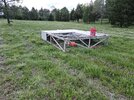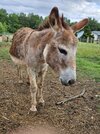We've got a coupla acres of pasture for one, and occasionally 2 horses. We've had this place for a coupla years and the folks before us used to hay this area.
Since we've taken it over it's gotten steadily worse as far as the quality of the pasture goes. The ground is pretty hard packed. We put lime down last fall or spring and that def helped with the buttercups. But not much else. There's a lot of that tough to mow stalky grass growing and I've been mowing it to try and keep the stalky stuff at bay.. We drag a harrow behind the golf cart to break up the horse piles (Poop Patrol!) There are occasional spots of what looks like real grass in some areas.
We did a soil test and she's got the results somewhere. I think the gist of it was to lay some lime.
The university sites make it sound pretty complicated. Curious if there's a middle ground.
FWIW we do have a small 30HP tractor..
Any of you guys have experience messin with this? Thanks.. 🤠
Since we've taken it over it's gotten steadily worse as far as the quality of the pasture goes. The ground is pretty hard packed. We put lime down last fall or spring and that def helped with the buttercups. But not much else. There's a lot of that tough to mow stalky grass growing and I've been mowing it to try and keep the stalky stuff at bay.. We drag a harrow behind the golf cart to break up the horse piles (Poop Patrol!) There are occasional spots of what looks like real grass in some areas.
We did a soil test and she's got the results somewhere. I think the gist of it was to lay some lime.
The university sites make it sound pretty complicated. Curious if there's a middle ground.
FWIW we do have a small 30HP tractor..
Any of you guys have experience messin with this? Thanks.. 🤠






